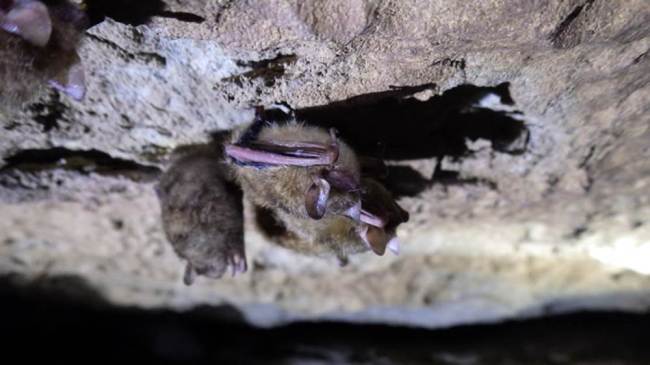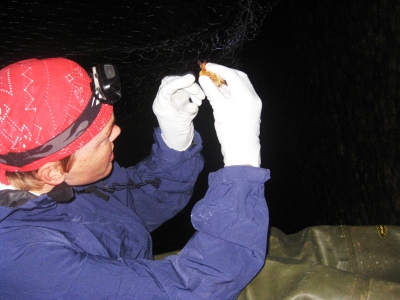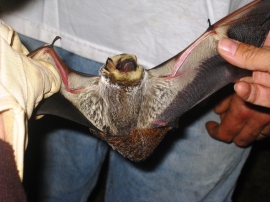WNS was first discovered in tricolored bats (Perimyotis subflavus) in Russell Cave in Jackson County, Alabama, in February 2012. In early 2013 the disease was confirmed in this same species in Fern Cave, also in Jackson County. In both cases, tricolored bats were confirmed to have WNS by the lab of the Southeastern Wildlife Disease Study located on the campus of the University of Georgia in Athens. Gray bats (Myotis grisescens) from Fern Cave appear to be carrying the fungus that causes WNS – Geomyces destructans (Gd). Five gray bats, including three live and two carcasses, were found to be Polymerase Chanin Reaction (PCR) positive, which indicates the presence of the genetic signature of Gd. However, four gray bat carcasses were collected in total and none had the skin invasion by the Gd which confirms the disease in bats. Thus, gray bats in Alabama are not known to be infected with the disease at this time.
Photos taken of tricolored bats by cavers in two other caves in Jackson County in early 2013 have the visual signs of WNS. However, specimens would have to be collected and tested before it could be determined for sure if bats in these caves are carriers or infected.
The current theory is that Gd begins skin invasion while bats are in torpor (similar to hibernation). Bats in torpor reduce the activity of many body functions including that of their immune system to conserve energy. This allows them to survive the winter on the fat deposits they put on eating available insects in summer and fall. The process of skin invasion by Gd irritates bats and they awaken more often during the period they are in torpor (often this is described as the hibernation period or season, but bats are not truly in hibernation because they normally awaken some during this season). Awakening from torpor requires the bats to expend energy. Over this wintering period the bats end up using all of their fat deposits prior to the end of winter. Bats begin to move toward cave entrances and have been observed numerous times further north flying around in the late winter. It is believed they are searching for insects because they have used up their fat reserves. Insects are not normally available at this time and the bats end up dying on the landscape, likely from starvation.
WNS may take more than one year to begin causing mortality of bats. It is not known at this time if bats in southern areas, like Alabama, will begin dying in the numbers seen further north. However, they could begin flying outside of infected caves in late winter in future years, perhaps as early as 2014. If it happens, it will likely occur around Jackson County first since the disease is spreading there.
Bats are not known to have the illness during the summer, although they may be carrying the spores (reproductive bodies produced by the fungus while it is growing on the bats in the winter) and show signs of wing damage. Sick bats during warmer periods of the year may be suffering from other illnesses, such as rabies. Sick bats observed outside caves during the winter may be impacted by WNS.
People who find sick bats should not handle them unless they have been vaccinated for rabies! If found during the winter or early spring, check the bats for signs of a white fuzz on exposed skin that you can see without handling them. Typical locations are around the nose, on the wings (including the forearms), and on the feet. Take photos if possible. Report the incident on this website. Be sure to provide information on the date, location, weather conditions, the size and color of the bat, whether the white fuzz was present, and other unusual conditions. Indicate whether you have photos available and your contact information. Having an e-mail address is handy should an Alabama Bat Working Group (ABWG) member need to contact you.
Members of the ABWG do not have the resources to investigate all incidences of sick or dead bats that may be observed. This will be even more true as WNS spreads if it causes a similar amount of mortality as in states further north. However, reports by the public may prove very important in helping us track the spread of this disease in Alabama and may help us determine where limited resources should be utilized to check bats for WNS in their wintering caves.
County or city health departments may be contacted if sick bats are found during the spring, summer, and fall to determine if they would like to test the bats for rabies. However, only someone with rabies vaccinations should handle the bats! Otherwise, you may be exposed to rabies.
The ABWG is composed of individuals interested in bat conservation and management. Members come from several state and federal agencies (for example, the Alabama Department of Conservation and Natural Resources, U.S. Fish and Wildlife Service, U.S. Forest Service, U.S. Department of Agriculture – Wildlife Services, and National Park Service), private non-profit groups (e.g., several grottos of the National Speleological Society and the Southeastern Cave Conservancy, Inc.), and interested members of the public. Please join us if you are interested in helping conserve and manage Alabama’s important bat populations. We typically have two meetings each year. The next meeting is to be held at the Wheeler National Wildlife Refuge Visitors Center in Decatur on Thursday, May 2, 2013 at 10:00 a.m.




 Posted by alabamabatwg
Posted by alabamabatwg 




